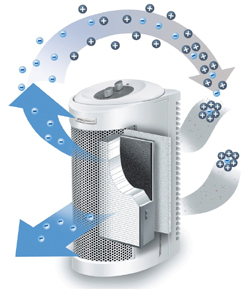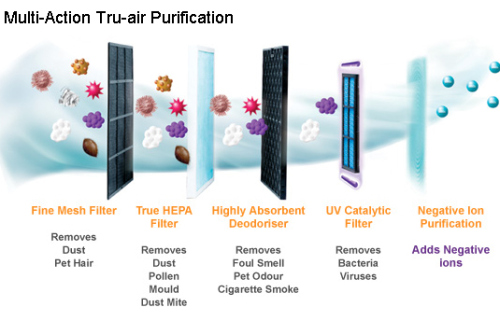Since the early 1990’s, there is a huge increase in indoor air pollution, especially in the metros.
It is estimated that people spend almost 80% of their time indoors (office or home).
So, there are more chances of you breathing the polluted air without even noticing it, thereby suffering with respiratory issues like asthma etc…

The situation is scary in Delhi, the capital city of India and other popular metros like Hyderabad, Mumbai, Pune, Bangalore etc..
Thanks to the latest technology, we now have the advanced air purifier systems that help in cleaning the air off harmful bacteria, viruses and other contaminants effectively.
Since they are mainly used to filter the air, the filters attract a lot of dust and debris, which will obstruct the passage of air.
When the air is not able to pass through the filter, then it will reduce its filtration efficiency greatly and can also increase your electricity bill as the air purifier need to put in extra efforts to purify the air.
So, cleaning the filters regularly (once every 4 to 6 months) will help improve the efficiency of the air filtration. Don’t worry! You can clean the filters yourself.
See: Best Air Purifiers for Car
Types of Filters Used in an Air Purifier
There are two categories of air purifiers, namely Active air purifiers and Passive air purifiers.

The Active air purifiers make use of ionization to clean the air, which is not good for our health as well as the environment (not ozone safe). Where as the Passive air purifiers simply make use of various types of filters to purify the air off dust particles and other harmful pollutants.
So, when compared, the Passive air purifiers are always better and healthier when compared to the active air purification systems.
Read: HEPA Air Purifier vs Ionizer
1. HEPA Filter
HEPA stands for High-Efficiency Particulate Air filter. This technology came into existence during the World War II.
It is used to eliminate the radioactive particles present in the air, thereby reducing the risk of respiratory issues among the soldiers.
The HEPA filter can remove even the tiniest particles with up to 99.97% efficiency. Hence, it is suggested by most doctors to their patients who are suffering with allergies or breathing issues.
The HEPA air filter can remove mold, debris, bacteria, viruses, minute pollen, tiny dust mites and other allergens from the air.
They can also eliminate cigarette smoke and odor in the room.

Another good thing about these HEPA filtration technology is that the contaminants, once collected, will not be thrown back into the air.
Read: Best Indoor Air Purifying Plants
2. UV Light Filter
UV stands for Ultraviolet light filters.
These are not just the regular filters. Despite collecting the impurities, they can also destroy the contaminants like bacteria, viruses, molds and yeasts present in the air.
These are ideal for situations where people repeatedly get sick and hence you’ll see them mostly in the hospitals in order to prevent infections and diseases from spreading.
They are very effective in eliminating the cigarette smoke, chemical fumes and bad odor.
The downside of UV filters is they cannot remove dust, solid particles and allergens present in the air.
3. Activated Carbon Filter
Activated carbon filter contains tiny pores, which help in attracting the pollutants like chemicals, gases, smoke and bad odor from the air.
These filters can function individually and always work with other filters in order to purify the air.
The activated carbon filter is most efficient when it comes to filtering organic chemicals present in our furniture and oil paints. They can also remove pet odor and moisture.
The only downside is that they are effective in removing dust or other tiny particles in the air.
4. Prefilter
These filters are like a gatekeeper, which stops the larger particles even before entering the main filter.
They help in improving the longevity of the main filter by decreasing its load.
So, the maintenance costs will also be decreased.
The prefilter is able to stop large debris, pollen, dust, hair furs etc…
The prefilter usually comes as either a separate piece or attached to the carbon filter.
These filters are reusable (removed and washed), which improves its efficiency further.
5. PM 2.5 Filter
PM 2.5 stands for Particulate Matter less than 2.5 micrometers.
The PM 2.5 particles are a by-product of rapid industrialization. They are formed mostly by burning fossil fuels.

These particles are extremely tiny in size and can easily enter through our respiratory tract to our lungs, thereby causing several health problems.
The PM 2.5 filters are specially designed to contain these tiny particles.
These filters are made of PTFE (Polytetrafluoroethylene) membrane and can withstand wear and tear for a longer period.
6. Catechin Filter
Catechin, which is an oxidant, has got many medicinal properties and is able to fight viruses and bacteria.
The catechin filter can eliminate bad odor from the smoke and pets.
It is mainly known for its durability.
With proper care and maintenance, the catechin filter can last for a decade or more.
7. Anti-Bacterial Filter
This filter, as the name suggests, destroy the bacteria, germs present in the air inside your room using ultraviolet rays.
The filter comes with a crumple carton resembling a mesh.
It usually comes in a single piece or combined with HEPA filter.
8. Anti-VOC Filter
VOC stands for Volatile Organic Compounds.
These carbon-containing compounds are usually emitted by paints, pesticides or new furnishing at home.
People who are sensitive to VOC usually get a headache or feel nauseous.
If there is poor ventilation at home and you’re staying indoors for most of the time, then you may definitely get severe health issues.
In case of any such symptoms, it is highly advised to use an air purifier or air conditioner with Anti-VOC filter to get rid of toxic VOC’s from your home.
9. Photocatalytic Filter
This air filter uses photocatalysis in order to purify the air off contaminants.
When the ultraviolet light falls on titanium dioxide, it releases electrons, which then react with water molecules in the air, thereby creating hydroxyl radicals (OH).
These OH radicals neutralizes the pollutants and turn them into non-toxic particles.
This entire process is known as Photocatalytic oxidation.
This photocatalytic filter is very efficient in removing the air irritants that cause lung infection and sore throat.
That’s all friends! These are the different types of filters used in the air purifiers, that help eliminate the allergens in the air, thereby providing 100% pure breathable air inside our home and car.

I have been wondering should I need to replace the air purifier filters regularly?
Prefilters usually lasts until the product is working, whereas the other filters like Activated carbon filter, HEPA filter etc… should be replaced after a set period of time. Read the entire guide to know the lifespan of each type of filter.